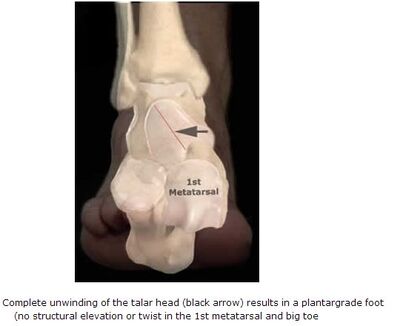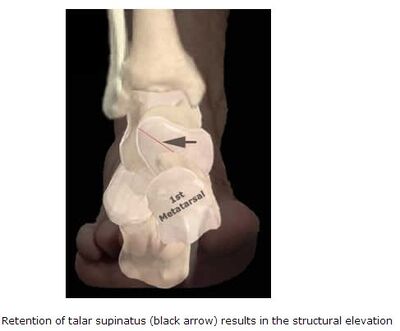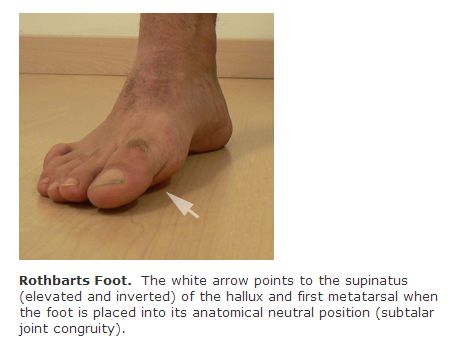What is Rothbarts Foot?
Rothbarts Foot is an abnormal embryological foot structure. It is the result of the incomplete ontogenetic torsional development of the neck and head of the talus (the bone that sits on top of the heel bone) that occurs approximately between the eighth and ninth week post ovulation.
The result of this incomplete development of the talus is that when the rear foot is placed in its anatomically neutral (correct) position, the big toe and its adjoining metatarsal are elevated off the ground (See photos below).

The diagram to the left shows the complete unwinding of the talar head (and neck) - termed talar normalus.
The diagram to the right show the retention of the twist in the talar head (and neck) - termed talar supinatus

The diagram to the left shows the position of the first metatarsal head when the talar head has fully unwound - termed metatarsus normalus
The diagram to the right shows the position of the first metatarsal head when the talar head has not fully unwound - termed metatarsus supinatus (AKA Rothbarts Foot)


Functionally, the Rothbarts Foot is an unstable foot structure. If one has a Rothbarts Foot, functionally, as the body’s weight is shifted from the rearfoot to the forefoot, gravity forces the supinatus (elevated and inverted) hallux and 1st metatarsal to roll inward, forward and downward until they rest on the ground.
This twisting motion of the foot is referred to as abnormal (gravity driven) pronation. Abnormal pronation results in postural distortions, which lead to chronic musculoskeletal pain (Rothbart 2011).
The supinatus of the hallux (big toe) and first metatarsal head is only visible when the subtalar joint is placed into its anatomical neutral position (joint congruity) - See Photo above.
References:
Rothbart BA, 2002. Medial Column Foot Systems: An Innovative Tool for Improving Posture. Journal of Bodywork and Movement Therapies (6)1:37-46
Rothbart BA. 2003 Etiology of Foot Hyperpronation - An Embryological Perspective. The Rothbart Foot Structure.British Journal of Osteopathy, Vol 26, pp 16-17
Rothbart BA 2011. Primus Metatarsus Supinatus (Rothbarts Foot): A common cause of musculoskeletal pain - Biomechanical vs Neurophysiological Model. Podiatry Review, Vol.68, No.4, pp 16-18 July/August.
Rothbart BA 2014. How Rothbarts Foot Leads to Poor Posture and Chronic Pain. Positive Health Online. Issue 211 (January) Bodyworks.
